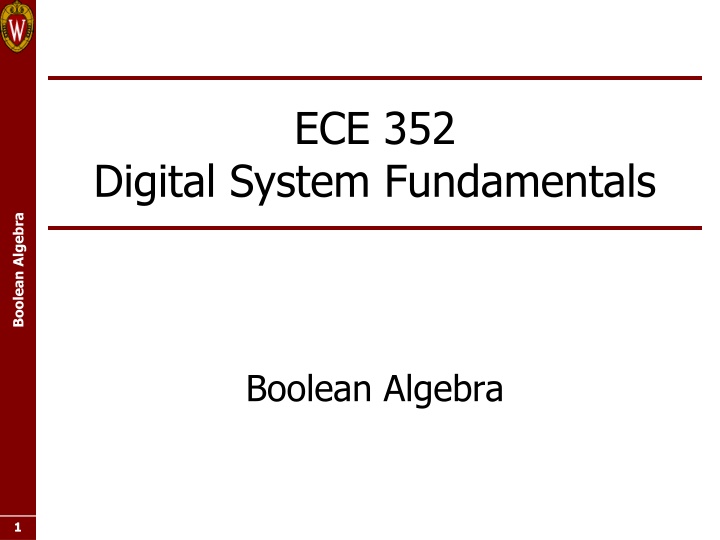
Digital Systems Fundamentals with Boolean Algebra and Circuit Implementation
Explore the basics of Boolean Algebra, Boolean Functions, Functional Waveforms, and Circuit Design. Understand how to express Boolean functions, minimize logic, and translate functions into logic gates. Enhance your knowledge of digital systems through hands-on learning opportunities.
Download Presentation

Please find below an Image/Link to download the presentation.
The content on the website is provided AS IS for your information and personal use only. It may not be sold, licensed, or shared on other websites without obtaining consent from the author. If you encounter any issues during the download, it is possible that the publisher has removed the file from their server.
You are allowed to download the files provided on this website for personal or commercial use, subject to the condition that they are used lawfully. All files are the property of their respective owners.
The content on the website is provided AS IS for your information and personal use only. It may not be sold, licensed, or shared on other websites without obtaining consent from the author.
E N D
Presentation Transcript
ECE 352 Digital System Fundamentals Boolean Algebra Boolean Algebra 1 1
Topics Boolean Algebra Boolean Functions Functional Waveforms Boolean Identities and Manipulations Boolean Algebra 2 2
Boolean Function Defined by a truth table, which is a complete representation of a Boolean function Same truth table can be implemented using different Boolean functions! If functions have identical truth tables, they are by definition functionally equivalent Different functions with the same truth table may differ in complexity this is why we use logic minimization Boolean Algebra Can also express the behavior of a Boolean function (or logic circuit) in response to different input values using a waveform Does not define the behavior, but can verify it 3 3
Functional Waveforms Express signal/circuit behavior over time 1 is high and 0 is low Given a set of input signals and their values over time, determine resulting output behavior Inputs may not occur in all possible combinations Input combinations may repeat Not definitive like a truth table! Boolean Algebra F = AB + C A B C F Can complete from left to right, but don t have to if the function is combinational 4 4
Circuits From Boolean Functions Functions are implemented using logic gates The circuit inputs are the function variables A literal is a single variable within a term (that may or may not be complemented) The circuit outputis the result Each Boolean function can be directly translated to a gate diagram that produces an output Think how you would read the function out loud... You would use the names of logic functions that each correspond to a gate! If we need more than one output, can create separate functions, separate circuits May be able to share a subset of circuitry Boolean Algebra 5 5
Boolean Algebra An algebra to work with Boolean values Similar to regular algebra except Boolean variables can only be 0 or 1; constants are only 0 or 1 Has operators, parentheses for precedence, etc. This allows us to manipulate Boolean functions Circuit/logic minimization Identify shared sub-functions (shared circuitry) Verify functionality Transform to use other types of gates or structures etc Boolean Algebra 6 6
Basic Boolean Identities X + 1 = 1 X + 0 = X X 1 = X X 0 = 0 X + X = 1 X X = 0 X + X = X X X = X X = X Boolean Algebra Commutative: X + Y = Y + X X Y = Y X Associative: X+(Y+Z) = (X+Y)+Z X (Y Z) = (X Y) Z Distributive: X (Y+Z) = X Y + X Z X + Y Z = (X+Y)(X+Z) De Morgan s: X + Y = X Y X Y = X+ Y 7 7
More Algebraic Manipulation Duality Principle: Dual of a circuit/equation: change ANDs to ORs, and change ORs to ANDs Taking the dual of both sides of a Boolean equation results in a valid equation Boolean Algebra Consensus Theorem: AB + AC + BC = AB + AC Provides a way to identify and remove a redundant term algebraically 8 8
Consensus Theorem AB + AC + BC = AB + AC + BC(A + A) = AB + AC + ABC + ABC = AB + ABC + AC + ABC = AB 1 + ABC + AC 1 + ABC = AB(1 + C) + AC(1 + B) = AB(1) + AC(1) = AB + AC Boolean Algebra 9 9
Why Simplify? More complex equation describes more complex circuit More area More delay More power and heat More work to create AB + AC + BC B Boolean Algebra A C AB + AC B A C 10 10
Complement of a Function The complement of a function is one that has the opposite truth table In the output column, change 0s to 1s and 1s to 0s Use De Morgan s Law BEWARE operator precedence and grouping Add parentheses if necessary! Can test if correct by comparing truth tables Boolean Algebra 11 11
Complement of a Function F = A(B + C) + A C F = A B + C + A C = A(B + C) A C Boolean Algebra = A + (B + C) ( A + C) = A + B C A+ C = A A+ AC + A B C+ B CC = 0 + AC + A B C+ 0 F = AC + A B C 12 12
ECE 352 Digital System Fundamentals Boolean Algebra Boolean Algebra 13 13
